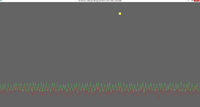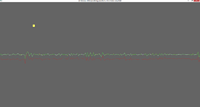The code does look correct. Is this specific to SDL 2.0.6 that you mention the version?
There are multiple things that could be responsible for what you are seeing. Here are few points you have to consider:
I’ve thrown a little program together that shows a bouncing square with a frame time graph. Maybe this helps you to spot an issue.
frametime.cpp
#include <iostream>
#include <string>
#include <deque>
#include <cmath>
#include <algorithm>
#include <vector>
#include "SDL.h"
#define FRAMETIME_COUNT 200
class Player {
public:
Player();
void update(const double tick_rate);
void draw(SDL_Renderer * renderer, const double alpha, int width, int height);
double x, y, px, py, vx, vy, ax, ay;
};
struct FrameTime {
double full, event, update, clear, draw, swap;
};
class Window {
public:
Window();
void init();
void quit();
void run();
void drawgraph();
void settitle();
void clear();
void swap();
SDL_Window * handle;
SDL_Renderer * renderer;
int width, height;
bool pause;
bool interpolate;
bool highprecision;
bool randomdelay;
bool biggraph;
bool showfullline;
bool showeventline;
bool showupdateline;
bool showclearline;
bool showdrawline;
bool showswapline;
Player player;
std::deque<FrameTime> frametime;
std::vector<SDL_Point> full_line;
std::vector<SDL_Point> event_line;
std::vector<SDL_Point> update_line;
std::vector<SDL_Point> clear_line;
std::vector<SDL_Point> draw_line;
std::vector<SDL_Point> swap_line;
};
static Uint32 xstate = 905309021;
static Uint32 xorshift() {
xstate ^= xstate << 13;
xstate ^= xstate >> 17;
xstate ^= xstate << 5;
return xstate;
}
Player::Player() : x(0.1), y(0.9), vx(0.35), vy(0), ax(0), ay(-0.5)
{}
void Player::update(const double tick_rate) {
px = x;
py = y;
vx += ax * tick_rate;
vy += ay * tick_rate;
x += vx * tick_rate;
y += vy * tick_rate;
if (x < 0 || x > 1) {
x = x < 0 ? -x : x - (x - 1);
vx = -vx;
}
if (y < 0 || y > 1) {
y = y < 0 ? -y : y - (y - 1);
vy = -vy;
}
}
void Player::draw(SDL_Renderer * renderer, const double alpha, int width, int height) {
const double interp_x = x * alpha + px * (1.0 - alpha);
const double interp_y = 1 - (y * alpha + py * (1.0 - alpha));
const int int_x = static_cast<int>(floor(interp_x * (width - 20) + 0.5));
const int int_y = static_cast<int>(floor(interp_y * (height - 20) + 0.5));
const SDL_Rect draw_rect = {int_x, int_y, 20, 20};
SDL_SetRenderDrawColor(renderer, 255, 255, 0, 255);
SDL_RenderFillRect(renderer, &draw_rect);
}
Window::Window() : handle(0), renderer(0), pause(false), interpolate(true), highprecision(false), randomdelay(false), biggraph(false),
showfullline(true), showeventline(true), showupdateline(true), showclearline(true), showdrawline(true), showswapline(true),
full_line(FRAMETIME_COUNT), event_line(FRAMETIME_COUNT), update_line(FRAMETIME_COUNT), clear_line(FRAMETIME_COUNT), draw_line(FRAMETIME_COUNT), swap_line(FRAMETIME_COUNT)
{}
void Window::init() {
if (SDL_Init(SDL_INIT_VIDEO | SDL_INIT_EVENTS) < 0)
throw "Could not init SDL";
handle = SDL_CreateWindow("Loading...", SDL_WINDOWPOS_CENTERED, SDL_WINDOWPOS_CENTERED,
800, 500, SDL_WINDOW_RESIZABLE);
if (!handle)
throw "Could not create window";
renderer = SDL_CreateRenderer(handle, -1, 0);
if (!renderer)
throw "Could not create renderer";
SDL_GetWindowSize(handle, &width, &height);
SDL_SetRenderDrawBlendMode(renderer, SDL_BLENDMODE_BLEND);
settitle();
clear();
swap();
}
void Window::quit() {
if (renderer)
SDL_DestroyRenderer(renderer);
if (handle)
SDL_DestroyWindow(handle);
if (SDL_WasInit(SDL_INIT_EVERYTHING))
SDL_Quit();
}
void Window::drawgraph() {
double graph_x_step = width / (double)(FRAMETIME_COUNT - 1);
int graph_height = biggraph ? height : (int)floor(std::max(height * 0.15, 10.));
int graph_top_y = height - graph_height;
int graph_mid_y = height - graph_height / 2;
SDL_SetRenderDrawColor(renderer, 255, 255, 255, 100);
SDL_Rect bg = {0, graph_top_y, width, graph_height};
SDL_RenderFillRect(renderer, &bg);
SDL_SetRenderDrawColor(renderer, 180, 180, 180, 200);
SDL_RenderDrawLine(renderer, 0, graph_top_y, width, graph_top_y);
SDL_SetRenderDrawColor(renderer, 100, 100, 220, 200);
SDL_RenderDrawLine(renderer, 0, graph_mid_y, width, graph_mid_y);
#define TRANSFORM_X(I) ((int)floor((I) * graph_x_step + 0.5))
#define TRANSFORM_Y(S) (height - 1 - (int)floor(((S) / (1. / 60. * 2)) * graph_height + 0.5))
size_t samplecount = frametime.size();
if (samplecount < 2)
return;
for (size_t i = 0; i < samplecount; i++) {
FrameTime & times = frametime.at(i);
full_line[i].x = TRANSFORM_X(i);
event_line[i].x = full_line[i].x;
update_line[i].x = full_line[i].x;
clear_line[i].x = full_line[i].x;
draw_line[i].x = full_line[i].x;
swap_line[i].x = full_line[i].x;
full_line[i].y = TRANSFORM_Y(times.full);
double s = times.swap;
swap_line[i].y = TRANSFORM_Y(s);
s += times.draw;
draw_line[i].y = TRANSFORM_Y(s);
if (swap_line[i].y == draw_line[i].y)
draw_line[i].y--;
s += times.clear;
clear_line[i].y = TRANSFORM_Y(s);
if (draw_line[i].y == clear_line[i].y)
clear_line[i].y--;
s += times.update;
update_line[i].y = TRANSFORM_Y(s);
if (clear_line[i].y == update_line[i].y)
update_line[i].y--;
s += times.event;
event_line[i].y = TRANSFORM_Y(s);
if (update_line[i].y == event_line[i].y)
event_line[i].y--;
}
if (biggraph) {
if (showeventline) {
SDL_SetRenderDrawColor(renderer, 255, 102, 255, 200);
SDL_RenderDrawLines(renderer, event_line.data(), (int)samplecount);
}
if (showupdateline) {
SDL_SetRenderDrawColor(renderer, 255, 255, 255, 200);
SDL_RenderDrawLines(renderer, update_line.data(), (int)samplecount);
}
if (showclearline) {
SDL_SetRenderDrawColor(renderer, 255, 255, 0, 200);
SDL_RenderDrawLines(renderer, clear_line.data(), (int)samplecount);
}
if (showdrawline) {
SDL_SetRenderDrawColor(renderer, 200, 200, 255, 200);
SDL_RenderDrawLines(renderer, draw_line.data(), (int)samplecount);
}
}
if (showswapline) {
SDL_SetRenderDrawColor(renderer, 255, 0, 0, 200);
SDL_RenderDrawLines(renderer, swap_line.data(), (int)samplecount);
}
if (showfullline) {
SDL_SetRenderDrawColor(renderer, 0, 255, 0, 200);
SDL_RenderDrawLines(renderer, full_line.data(), (int)samplecount);
}
}
void Window::clear() {
SDL_SetRenderDrawColor(renderer, 0, 0, 0, 0);
SDL_RenderClear(renderer);
}
void Window::swap() {
SDL_RenderPresent(renderer);
}
void Window::settitle() {
static std::string title(128, 0);
SDL_RendererInfo info;
SDL_GetRendererInfo(renderer, &info);
title.assign(info.name);
title.append(interpolate ? ", interpolating position" : ", not interpolating");
title.append(highprecision ? ", microsec counter" : ", millisec counter");
if (randomdelay)
title.append(", random delay");
SDL_SetWindowTitle(handle, title.c_str());
}
static double Timer(bool highprecision) {
if (highprecision) {
static double period = 1. / SDL_GetPerformanceFrequency();
return SDL_GetPerformanceCounter() * period;
}
return SDL_GetTicks() / 1000.0;
}
void Window::run() {
SDL_Event e;
FrameTime ft;
int run = 1;
double time_last_event = Timer(highprecision);
double accumulator = 0.0;
double tick_rate = 1.0 / 60.0;
while (run) {
double time_frame_start = Timer(highprecision);
while (SDL_PollEvent(&e)) {
if (e.type == SDL_QUIT) {
run = 0;
} else if (e.type == SDL_KEYUP) {
Uint32 sym = e.key.keysym.sym;
if (sym == SDLK_ESCAPE) {
run = 0;
} else if (sym == SDLK_SPACE) {
pause = !pause;
} else if (sym == SDLK_1) {
showfullline = !showfullline;
} else if (sym == SDLK_2) {
showeventline = !showeventline;
} else if (sym == SDLK_3) {
showupdateline = !showupdateline;
} else if (sym == SDLK_4) {
showclearline = !showclearline;
} else if (sym == SDLK_5) {
showdrawline = !showdrawline;
} else if (sym == SDLK_6) {
showswapline = !showswapline;
} else if (sym == SDLK_i) {
interpolate = !interpolate;
settitle();
} else if (sym == SDLK_p) {
highprecision = !highprecision;
double difference = Timer(highprecision) - Timer(!highprecision);
time_frame_start += difference;
time_last_event += difference;
settitle();
} else if (sym == SDLK_r) {
randomdelay = !randomdelay;
settitle();
} else if (sym == SDLK_b) {
biggraph = !biggraph;
}
} else if (e.type == SDL_WINDOWEVENT) {
if (e.window.event == SDL_WINDOWEVENT_RESIZED || e.window.event == SDL_WINDOWEVENT_SIZE_CHANGED) {
width = e.window.data1;
height = e.window.data2;
}
}
}
const double time_event = Timer(highprecision);
double last_frame_time = time_event - time_last_event;
time_last_event = time_event;
if (!pause) {
if (last_frame_time > 0.25)
last_frame_time = 0.25;
accumulator += last_frame_time;
while (accumulator >= tick_rate) {
player.update(tick_rate);
accumulator -= tick_rate;
}
}
const double alpha = accumulator / tick_rate;
if (randomdelay) {
double delay_end = Timer(highprecision) + (xorshift() % 16 + 5) / 1000.;
while (delay_end >= Timer(highprecision)) {
}
}
const double time_update = Timer(highprecision);
clear();
const double time_clear = Timer(highprecision);
player.draw(renderer, interpolate ? alpha : 1, width, height);
drawgraph();
const double time_draw = Timer(highprecision);
swap();
const double time_swap = Timer(highprecision);
if (pause)
continue;
ft.full = time_swap - time_frame_start;
ft.event = time_event - time_frame_start;
ft.update = time_update - time_event;
ft.clear = time_clear - time_update;
ft.draw = time_draw - time_clear;
ft.swap = time_swap - time_draw;
if (frametime.size() >= FRAMETIME_COUNT)
frametime.pop_front();
frametime.push_back(ft);
}
}
int main(int argc, char * argv[]) {
Uint64 t = SDL_GetPerformanceCounter();
xstate = (Uint32)(t | (t >> 32));
Window window;
try {
window.init();
window.run();
} catch(const char * msg) {
std::cout << msg << std::endl;
} catch(...) {
std::cout << "Unexpected exception" << std::endl;
}
window.quit();
return 0;
}

